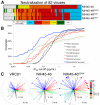Increasing the potency and breadth of an HIV antibody by using structure-based rational design
- PMID: 22033520
- PMCID: PMC3232316
- DOI: 10.1126/science.1213782
Increasing the potency and breadth of an HIV antibody by using structure-based rational design
Abstract
Antibodies against the CD4 binding site (CD4bs) on the HIV-1 spike protein gp120 can show exceptional potency and breadth. We determined structures of NIH45-46, a more potent clonal variant of VRC01, alone and bound to gp120. Comparisons with VRC01-gp120 revealed that a four-residue insertion in heavy chain complementarity-determining region 3 (CDRH3) contributed to increased interaction between NIH45-46 and the gp120 inner domain, which correlated with enhanced neutralization. We used structure-based design to create NIH45-46(G54W), a single substitution in CDRH2 that increases contact with the gp120 bridging sheet and improves breadth and potency, critical properties for potential clinical use, by an order of magnitude. Together with the NIH45-46-gp120 structure, these results indicate that gp120 inner domain and bridging sheet residues should be included in immunogens to elicit CD4bs antibodies.
Figures




References
Publication types
MeSH terms
Substances
Associated data
- Actions
- Actions
Grants and funding
LinkOut - more resources
Full Text Sources
Other Literature Sources
Research Materials

